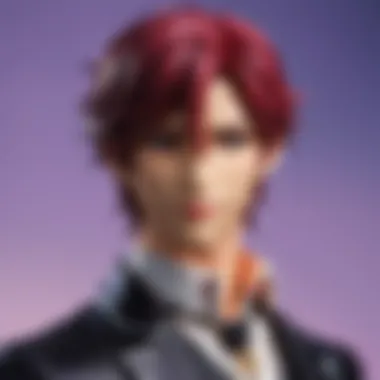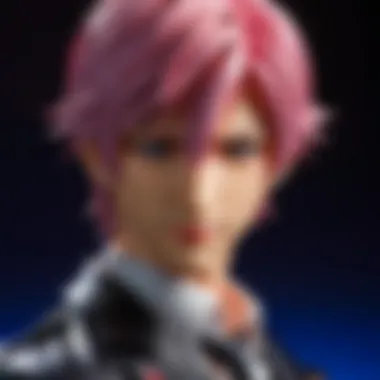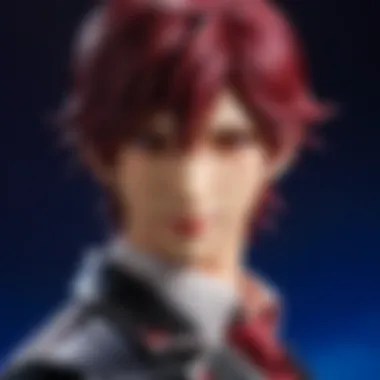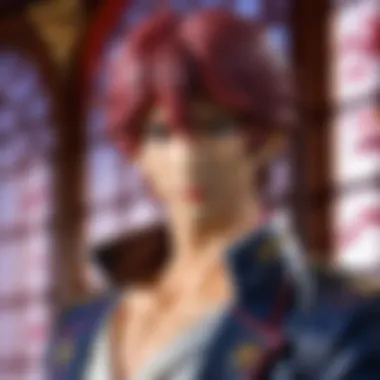Exploring the Depths of Diabolik Lovers: More Blood


Intro
The realm of otome games has seen numerous entries, yet few have captured the complex emotions and narratives as effectively as Diabolik Lovers: More Blood. This series stands out for its intricate storytelling and dynamic character development, drawing a diverse audience of both gamers and collectors. In this article, we will delve into the key components that shape the Diabolik Lovers franchise, examining everything from its plot intricacies to its impact within Japanese media.
The significance of this franchise extends beyond pure entertainment. It taps into darker themes, catering to a niche that appreciates a blend of horror and romance. With characters that resonate deeply, each offering a unique perspective on love and power dynamics, the series has carved its own identity. In addition to this, we explore the collectible aspect of Diabolik Lovers, discussing figures and merchandise that appeal to fans and collectors alike, enriching the experience of engaging with the franchise.
Through this exploration, our aim is to provide a comprehensive understanding of Diabolik Lovers: More Blood—its elements, its allure, and how it fits within the cultural landscape of anime and video games. The following sections will elucidate various dimensions of the series, spotlighting its various facets along the way.
Preamble to Diabolik Lovers
The world of Diabolik Lovers offers a unique entry point into the realm of otome games, characterized by its distinct narrative style and thematic richness. This introduction seeks to highlight the significance of the Diabolik Lovers franchise within the larger context of interactive storytelling in video games. The series, which intertwines elements of romance, horror, and drama, fosters a complex relationship between player choice and narrative outcomes.
In this section, the intention is to present an overview of the franchise, laying the groundwork for deeper discussion in following sections. Collectors and enthusiasts often see more than just a simple gaming experience; they recognize the cultural phenomena surrounding Diabolik Lovers. Understanding its impact and evolution helps illuminate its role not only in gaming but also in anime and Japanese media.
Overview of the franchise
Diabolik Lovers was first released as a visual novel by the Japanese company Rejet in 2012. It quickly gained popularity, leading to additional titles and adaptations. The central premise revolves around a female protagonist and her interactions with a group of vampires. This concept, while rooted in the broader tropes of vampire romance, is presented with a dark twist that sets it apart from other works in the genre.
The narrative is laden with dramatic tension and psychological themes. Players navigate choices that influence character relationships and storyline development. Characters are often depicted with intricate backstories, which contributes to their depth and relatability.
Notably, the franchise has expanded into anime adaptations, manga, and various merchandise. This transmedia presence demonstrates its significance in contemporary pop culture, particularly among fans of Japanese media.
The evolution of otome games
Otome games, originally a niche genre aimed at female audiences, have experienced considerable growth in recent years. They combine storytelling, character interaction, and player choices, creating immersive experiences. Diabolik Lovers stands as a pivotal example in this evolution, merging romance with elements of horror and suspense.
This evolution includes the incorporation of complex narratives, improved graphics, and more dynamic gameplay mechanics. The genre now appeals to a wider audience. As fans seek stories that provide both engagement and emotional depth, the expectations from otome games have shifted.
Ending of the section
In summary, the Diabolik Lovers franchise serves as a significant case study in understanding the development and impact of otome games. Its unique contribution to the genre highlights both the artistic expression found within visual novels and the cultural relevance these games hold in the broader landscape of media. Through this exploration, readers can grasp not only the allure of Diabolik Lovers but also its importance as a cultural artifact in the gaming world.
Narrative Structure of More Blood
The narrative structure of Diabolik Lovers: More Blood is crucial for understanding its complex interplay of character dynamics and thematic elements. This section delves into how the plot unfolds, the relationship between the characters, and how these factors contribute to the overall experience of the game. An intricately woven narrative is essential in otome games, as it shapes player engagement and emotional investment. The depth of the story in More Blood enhances its appeal, providing a multifaceted experience that goes beyond surface-level interactions. Through this analysis, readers can appreciate the architecture of the narrative that supports both character development and thematic exploration.
Plot synopsis
Diabolik Lovers: More Blood continues the story of Yui Komori, a human girl who finds herself entangled with a group of attractive yet dangerous vampire brothers. The plot picks up directly after the events of the first installment, Diabolik Lovers. Yui is trying to navigate her complicated relationship with these vampires, who are not only charming but also possess dark secrets and insatiable bloodlust.
As Yui struggles with her feelings, she uncovers hidden truths about her own past and the brothers' shared history. Each character presents a unique storyline, allowing Yui to choose which relationships to explore. These choices significantly influence the game's outcome, leading to various endings based on Yui’s decisions and interactions. The real-time progression of the plot and its branching paths create a rich tapestry of experiences that reflect the consequences of choices made by the player.
Themes and motifs


The themes in More Blood delve into love, betrayal, and the quest for identity against a backdrop of darkness and obsession. Central to the narrative is the concept of power dynamics, particularly how the relationships between humans and vampires shift throughout the story. The game explores love not just as a romantic concept but as an obsession that can lead to destructive outcomes.
- Identity and self-discovery: Yui's journey represents a deep search for her true self amidst conflicting emotions and predicaments. This theme resonates with many players, who might see reflected aspects of their own journeys in her struggles.
- Power and control: The relationship dynamics are often characterized by manipulation and dominance, which challenges the player's understanding of consent and agency within romantic entanglements.
- Isolation and connection: Many characters experience profound loneliness, emphasizing the human need for connection juxtaposed against the vampires' isolated existences.
"The narrative's examination of these themes not only invites reflection but also solidifies its cultural significance within the genre."
In summary, the plot synopsis and thematic exploration of Diabolik Lovers: More Blood serve to create an immersive experience that captivates both new players and returning fans. Each element of the narrative structure plays a significant role in fostering a deeper understanding of the characters and their intertwined fates.
Character Analysis
In the landscape of visual novels, character depth is paramount. In "Diabolik Lovers: More Blood," character analysis takes center stage, providing insight essential not only to understanding individual motivations but also to uncovering the overarching themes of the narrative. Each character contributes to the emotional atmosphere and technical artistry of the game, making the analysis crucial for appreciating the intricate storytelling.
Protagonist exploration
The protagonist of "More Blood," Yui Komori, stands at the heart of the story. Her character is crafted as a vessel through which players navigate the complex dynamics of love and power. Yui's experiences, choices, and interactions with vampire characters drive the narrative. Through her perspective, players experience the nuances of fear, desire, and moral ambiguity. Her growth as a character, from innocence to a more assertive presence, mirrors the transformation seen in traditional otome game protagonists, yet offers a unique take on autonomy in a predatory environment.
By analyzing Yui's character, we explore her motivations and the internal conflicts that arise as she interacts with the various vampires. Yui's relationships illustrate themes of submission and resistance, revealing the psychological depth that characterizes the game's narrative. This exploration allows for a deeper understanding of her role as more than just a passive participant in the love interests' dynamics.
Vampire characters overview
The vampire characters in "Diabolik Lovers: More Blood" serve as complex metaphors for various human emotions and societal constructs. Each vampire embodies distinct traits and backstories, influencing their interactions with Yui and each other. For instance, the Sakamaki brothers each represent different aspects of desire and jealousy, creating a rich tapestry of relationships that compel player engagement.
Each vampire's character design is also significant. The visual styles range from elegant to chaotic, reflecting their personalities and histories. The dynamics between these characters offer insight into the broader themes of connection and isolation, power struggles, and the nature of love in dark contexts. Their development throughout the game not only enhances the intrigue but also reveals insights into the societal themes present in otome games as a whole.
Supporting characters and their roles
Supporting characters in "More Blood" add layers of complexity to the narrative. Figures such as the Mukami brothers and the antagonistic forces introduce varying conflicts and motives. Their presence is not merely ornamental; they play critical roles in shaping Yui's choices and experiences.
These characters often challenge the protagonist, prompting players to reflect on morality and personal growth. The interactions they foster among the main cast lead to numerous pathways and potential endings, emphasizing the significance of choices within the game mechanics. The varying relationships established through supporting characters reveal a broader examination of loyalty, betrayal, and the multifaceted nature of love and desire in an unforgiving world.
Game Mechanics
Game mechanics are essential to the overall experience of any video game, and this holds true for Diabolik Lovers: More Blood. Understanding the mechanics not only enhances immersion but also enriches the narrative experience by giving players agency in the story. This section will delve into the intricate gameplay dynamics, the impact of choices, and the audio-visual components that together shape the engaging world of this title.
Gameplay dynamics
The gameplay dynamics in More Blood consist of visual novel elements combined with interactive gameplay features. Players navigate the story through on-screen choices that impact the progression of the narrative. This structure allows individuals to engage closely with characters, fostering emotional ties and investment in outcomes. The pacing of the game can also shift dramatically, maintaining a tension that enhances critical decision-making moments.
Players often find themselves confronted with multiple paths, each leading to distinct storylines and potential character outcomes. As players make choices, they experience a sense of control, which is compelling and critical for building attachment to the narrative.
Furthermore, there are moments when characters respond based on previous interactions, enhancing the realism of player choices. This connection provides a deeper understanding of character motivations and invites players to explore various perspectives throughout the game.
Choices and their consequences


In Diabolik Lovers: More Blood, choices are not mere decorations; they are fundamental to the unfolding drama. Each decision made by the player carries weight, affecting relationship dynamics and plot trajectories. A seemingly minor choice can lead to significant changes in the narrative, which is a hallmark of engaging storytelling in otome games.
The consequences of player decisions can lead to multiple endings. This encourages exploration, ensuring that players have reason to revisit the game.
Players may find themselves asking critical questions after making choices: Did I alienate a character? Could I have gained trust with someone else? This model places players in a unique position, where their reactions shape the game world. In addition to emotional storytelling, these mechanics underscore the complexity of relationships, reflecting the themes of love, betrayal, and desperation.
Visual and audio elements
The visual and audio elements that accompany More Blood are key to creating its atmospheric setting. Character designs are often intricate, with detailed artwork reflecting their unique traits and personalities. Locations within the game are depicted with a gothic aesthetic that amplifies the foreboding atmosphere peppered throughout the storyline.
Audio plays a critical role as well. The soundtrack heightens emotional moments, transitioning seamlessly between tension and relief. Voice acting adds layers to the character’s emotions, enriching the narrative and enhancing player immersion.
The synergy between these visual and audio components creates an experience that engages multiple senses. This commitment to quality is evident and further solidifies More Blood as a notable entry in the otome genre, appealing to fans who appreciate depth and craftsmanship in storytelling.
Cultural Impact and Popularity
The cultural impact and popularity of Diabolik Lovers: More Blood represent an intriguing blend of storytelling, character engagement, and the evolution of fan interaction with the franchise. This section will delve into several important aspects of its cultural significance, including how fans connect with the series and the proliferation of merchandise that ensues from its fame.
Fan community engagement
The fan community surrounding Diabolik Lovers is both passionate and diverse. Online platforms such as Reddit and Facebook provide spaces for fans to discuss plot points, character motivations, and personal experiences related to the game. These discussions often lead to various fan theories, artistic creations, and even fan fiction, extending the narrative beyond its original format. The nature of engagement is particularly notable as it brings together individuals with shared interests across geographical boundaries.
Moreover, social media plays a crucial role in community building within the Diabolik Lovers fan base. Fan artists frequently share their work on platforms like Twitter and Instagram, creating a visual representation of their interpretations of characters and scenes. This creative output not only showcases talent but also fosters a sense of belonging among fans. Events, both virtual and live, such as anime conventions, often feature panels and discussions about the game. These gatherings enhance the overall experience of being a part of the Diabolik Lovers community, reinforcing relationships among fans and creating opportunities for dialogue about the franchise.
Merchandise and collectibles
The demand for merchandise related to Diabolik Lovers is a reflection of its popularity. Many fans actively seek out collectibles, ranging from figurines to apparel. Official merchandise often includes keychains, plush toys, and art books that provide deeper insight into the lore of the game. This form of engagement not only allows fans to connect more personally with the characters but also serves as a means of showcasing their fandom.
Moreover, the emergence of unofficial merchandise highlights a unique aspect of fan culture. Artists frequently create their own designs for Diabolik Lovers themed items, contributing to a vibrant marketplace that thrives on creativity and personal expression. Limited edition items draw significant attention, often selling out quickly, demonstrating the commitment of fans to the franchise.
In summary, the cultural impact of Diabolik Lovers: More Blood is multifaceted. From vibrant community participation to the thriving market for unique merchandise, the franchise has carved out a notable place in popular culture. The engagement of fans enhances the narrative and allows for ongoing discussions that keep the franchise alive and relevant.
Comparative Analysis
A comparative analysis serves as a crucial element within the examination of Diabolik Lovers: More Blood. It allows for a deeper understanding by placing this specific title in relation to other notable entries in the otome game genre. Through this comparison, both casual players and dedicated collectors can glean insights about narrative execution, character design, and gameplay mechanics that define the series. The objective here is to assess how More Blood distinguishes itself while also reflecting broader trends in otome gaming.
Comparison with other otome games
When placing Diabolik Lovers: More Blood alongside other well-known otome titles such as Mystic Messenger and Hakuoki: Stories of the Shinsengumi, several distinctions can be identified. First, the overall atmosphere of More Blood leans heavily toward the gothic and horror themes, creating a unique sense of narrative tension. In contrast, Mystic Messenger incorporates modern communication elements and maintains a lighter tone, focused on mystery and romance without the darker undertones.
Another point of comparison lies in the character dynamics. While in Hakuoki, characters typically undergo clear arcs leading to resolutions, More Blood frequently leaves character motivations ambiguous. This ambiguity fosters a sense of intrigue but can also frustrate players looking for clear emotional payoffs. Additionally, the gameplay dynamics in More Blood require players to navigate through complex relationships with the vampire characters, often revolving around themes of power and control. This marks a significant departure from the more straightforward romance paths seen in other games.
- Unique Features of More Blood:


- Darker themes around relationships and power dynamics
- Ambiguous character motivations that challenge player interpretations
- Emphasis on gothic horror over lighthearted romance
In doing this comparative analysis, one can appreciate the distinct niche More Blood occupies within the otome genre. It appeals to players less concerned with traditional romantic narratives and more intrigued by psychological depth.
Influence of anime adaptations
The influence of anime adaptations on games like Diabolik Lovers: More Blood is profound. The anime, which aired after the game's release, helped to popularize the characters and expand the universe. For a collector or a fan, understanding this relationship enhances the appreciation of the game’s intricate storytelling and character design. As the anime adaptation succeeded in reaching wider audiences, many new players turned to the game in hopes of exploring the deeper, interactive narrative that the anime could not fully encapsulate.
Moreover, the visual and auditory elements—integral to the game's experience—are amplified by the richly animated characters seen in the anime. This cross-platform synergy engages fans more fully and fosters a community that transcends singular media formats. The character-centric narratives encouraged by the anime also reflect in how the game is designed, allowing players to form deeper connections and draw comparisons to character portrayals within the series.
Alan viewing the outcomes of these adaptations, we see a potential domino effect; an increase in anime popularity often results in heightened interest in associated games. As fans become captivated by storylines and character developments in the anime, they are naturally inclined to explore the interactive dimensions that games like Diabolik Lovers: More Blood provide.
Ultimately, More Blood represents a notable case study in the realm of otome games, demonstrating the impact of visual storytelling through both gaming and anime. By analyzing these influences, collectors and fans can better understand the cultural significance of the series and its growing legacy in the broader landscape of Japanese media.
Future Prospects
The future prospects of the Diabolik Lovers franchise present a significant area of discussion in this article. This segment delves into the anticipated developments within the series and broader implications for the otome game genre. As the gaming landscape evolves, understanding these future directions is crucial for fans and collectors. It provides insight into how narratives in this genre may develop, and it may influence collecting strategies and fan engagement strategies. With a dedicated fanbase, the expectations for the franchise's growth are high.
Expected developments in the Diabolik Lovers series
Several key developments are likely to shape the future of the Diabolik Lovers series. There is a noticeable demand for more content following the popularity of More Blood. Fans eagerly await new story arcs and character expansions, which can deepen the existing lore. The following elements could emerge in upcoming releases:
- New characters: Introduction of additional vampire or supporting characters to enrich the narrative.
- Alternate storylines: Expansion of routes for current characters, allowing players to experience different perspectives and outcomes.
- Cross-media projects: Possible adaptations into manga or light novels, which could draw in new fans and enrich the franchise.
- Gameplay innovations: Advances in game mechanics and interface that enhance user experience and immersion.
The evolving nature of mobile and console gaming could also enable Diabolik Lovers to find new ways to interact with its audience.
Predictions for the genre
The Diabolik Lovers franchise is likely to influence the future of otome games significantly. As its themes resonate with players, other developers may strive to emulate its success. Key predictions include:
- Focus on character-driven narratives: Similar to Diabolik Lovers, future games may prioritize deep storytelling and character development.
- Increased engagement systems: Games may adopt social interaction elements, where players connect directly with characters in real-time.
- Greater accessibility: The rise of mobile platforms might lead to more accessible versions of traditional otome games, increasing participation from diverse demographics.
- Integration of technology: Use of virtual reality or augmented reality to provide a more immersive gameplay experience.
"The future is where dreams and realities converge, leading us to new horizons of interactive storytelling and character exploration."
Finale
In summing up the exploration of Diabolik Lovers: More Blood, it is essential to recognize the multifaceted nature of this visual novel and its contributions to the otome game genre. The narrative intricacies, character development, and thematic depth presented in More Blood significantly elevate the experience for players. This analysis brings to light how these elements interweave to create a captivating environment for both fans and new players.
One of the most notable aspects of More Blood is its ability to evoke emotional responses through complex storytelling. The strategic choices players make influence character relationships and plot outcomes, making each playthrough unique. Additionally, the variety of character arcs showcases diverse human experiences, from love to betrayal, resonating with a broad audience.
Furthermore, there is a notable cultural impact that More Blood has within the larger context of Japanese media. The series has fostered a dedicated fanbase that engages actively through social media platforms like Reddit and various merchandise that enhances the overall experience. Collectors find value in the physical representations of their favorite characters, while anime fans immerse themselves in the adaptations that bring these narratives to life.
Final thoughts on More Blood
The exploration of Diabolik Lovers: More Blood emphasizes a significant advancement in otome games. The combination of engaging narratives and character relationships invites players to invest in the outcome of their choices. Having a protagonist with relatable struggles enhances player immersion and connection with the story, which stands out in the otome genre.
Moreover, the thematic elements present a blend of romance and supernatural intrigue, appealing to a wide audience. This mixture provides layers of meaning that deepen enjoyment, encouraging discussions among fans who share interpretations and experiences.
Ultimately, Diabolik Lovers: More Blood is a vital piece in the otome genre's evolution. Its impact resonates through various platforms and within fan communities, making it a notable title that deserves attention and exploration. Collectors and casual players alike can find not only entertainment but also deeper engagement with the themes that challenge and inspire.



